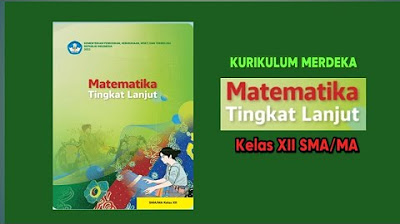PENINJAUAN TOPIK DAN PENILAIAN MAPEL EKONOMI | PERTEMUAN 1 [PART 1/2]
Summary
TLDRThis video provides an overview of the 10th-grade Economics curriculum for high school students. It covers key learning objectives and indicators, including the concept of scarcity, distinguishing needs from wants, and understanding economic principles like supply and demand. Topics include the history of economics, human needs, resource scarcity, economic activities (production, distribution, consumption), market functions, and financial institutions. The video also outlines assessment methods for students, such as attitude, knowledge, and skills, emphasizing group collaboration, problem-solving, and applying economic concepts to real-world scenarios.
Takeaways
- 😀 The video discusses the topic of economic assessment and key concepts for 10th-grade students in high school.
- 😀 The content is divided into four main parts: objectives and indicators of learning, economic concepts, assessment of learning achievements, and a reflection on scarcity in daily life.
- 😀 One of the objectives is for students to distinguish between needs and wants, and understand the concept of scarcity in economics.
- 😀 The learning outcomes also aim to enhance students' ability to apply economic concepts in real-life situations.
- 😀 Key topics covered in the curriculum include the history of economics, human needs, scarcity of resources, priority scales, financial literacy, and the economics of production, distribution, and consumption.
- 😀 The video explains that economic markets are formed through demand and supply, and it also delves into the concept of price formation in markets.
- 😀 Financial institutions are introduced as part of the curriculum, with a focus on banks and non-bank financial industries.
- 😀 Economic assessments are divided into three areas: attitude, knowledge, and skills.
- 😀 For attitude assessment, three main values are focused on: mutual cooperation, independence, and problem-solving skills.
- 😀 Knowledge assessments involve understanding the material and applying it to various case studies, with tasks, midterm exams, and final exams as key evaluation tools.
- 😀 Skill assessments encourage group collaboration, where students are tasked with conducting simple research to explain economic phenomena, which will be presented to the class.
Q & A
What is the focus of this video?
-The video focuses on the assessment and topics of the 10th-grade Economics subject in high school, covering the objectives, learning indicators, and material of the course.
What are the four main parts of the discussion in this video?
-The video discusses four main parts: 1) Economic learning objectives and indicators, 2) Economic material and assessment indicators, 3) Economic concepts and scarcity in daily life, and 4) Assessment in Economics, including attitude, knowledge, and skill evaluation.
What are the key objectives of the 10th-grade Economics course?
-The course aims to help students understand the concept of economics, distinguish between needs and wants, comprehend scarcity in daily life, and analyze various economic phenomena.
How does the video describe the relationship between human needs and scarcity?
-The video explains that the concept of human needs and scarcity is interconnected, and students are expected to analyze these concepts in relation to real-world situations.
What are the main components of the Economics material for this class?
-The material consists of: 1) Economic concepts, including the history of economics, human needs, scarcity of resources, prioritization, and financial literacy; 2) Economic activities like production, distribution, and consumption; 3) Market functions, including supply and demand, price formation, and economic activities; 4) Financial institutions such as banks and non-bank financial industries.
What are the three main types of assessment in the Economics subject?
-The three types of assessment are: 1) Attitude assessment, focusing on values like mutual cooperation and independence; 2) Knowledge assessment, evaluating understanding of material and case associations; 3) Skill assessment, which involves group projects and practical tasks like presenting research.
What specific values are emphasized in the attitude assessment for Economics?
-The attitude assessment emphasizes values like mutual cooperation (seen in active participation in discussions), independence (such as being punctual and completing tasks on time), and problem-solving ability.
How is knowledge assessed in this subject?
-Knowledge is assessed through understanding the material, applying it to various real-life cases, and evaluating students’ performance in tasks, including individual and group assignments.
What does the skill assessment involve?
-The skill assessment involves group collaboration to conduct simple research on economic phenomena, present findings to the class, and analyze issues related to economics in the surrounding environment.
What are the expected outcomes for students at the end of the 10th-grade Economics course?
-By the end of the course, students should be able to reflect on the concept of scarcity in daily life, distinguish between needs and wants, understand pure economic concepts, and apply their learning to analyze economic activities in their surroundings.
Outlines

This section is available to paid users only. Please upgrade to access this part.
Upgrade NowMindmap

This section is available to paid users only. Please upgrade to access this part.
Upgrade NowKeywords

This section is available to paid users only. Please upgrade to access this part.
Upgrade NowHighlights

This section is available to paid users only. Please upgrade to access this part.
Upgrade NowTranscripts

This section is available to paid users only. Please upgrade to access this part.
Upgrade NowBrowse More Related Video

PEMBAGIAN ILMU EKONOMI | EKONOMI X

SMA KELAS X Geografi Fase E : Fenomena Geosfer Di Indonesia "PEDOSFER"

Program Tahunan Kurikulum Merdeka Belajar SMA - Guru BK Siap

Kurikulum Merdeka Rangkuman Pancasila Kelas 9 Bab 2

Matematika tingkat lanjut kelas XII (12) SMA /MA Kurikulum merdeka @GUcilchaNEL1964

Pinnacle+ School System: Ensure Every Student Excels
5.0 / 5 (0 votes)